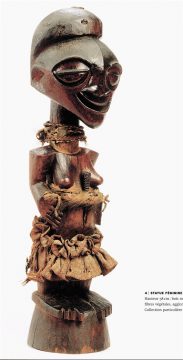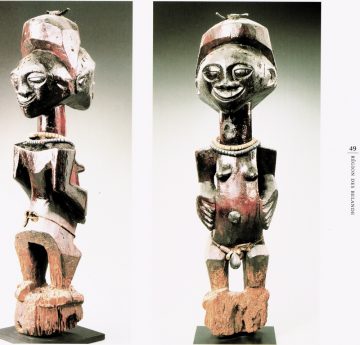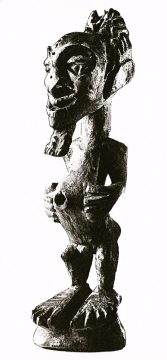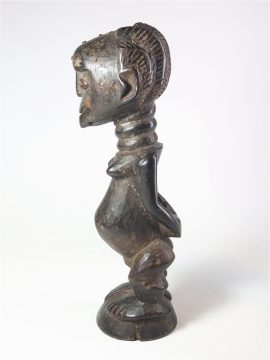Published 14 february 2017
Original Version: 10 february 2017
What kind of figure?
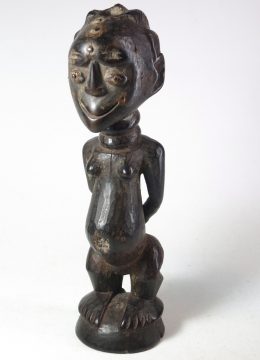 Fetish (Nkishi): openings in the back and navel
Fetish (Nkishi): openings in the back and navel
Slave: her hands bound together – Felix (100 Peoples) mentions the traditional status of slaves.It cannot be someone else.
Beautiful woman: elaborate noble hairstyle with shaved forehead, straight and quite long neck with three rolls; The woman wears 11 tiny copper nails as ornament: 3 from the nose to the back, 2 to the eyes, 6 to the right and left of the temples; she has expressive bean eyes (elevations plus nails) and a disarming smile like a smiley face .She looks directly at the viewer with raised and marked eyebrows and sharp eyes, Her smile conveys serenity.She is very pregnant with an attractive belly, hollow lower back and nice buttocks.The attitude is impeccable. The master did nothing superfluous: no jewels on the fuselage (So sure, that she is Songye!)
Style, Design, Care, and Condition – A Perfect Miniature of 21 cm
Proportions: classic and vital. Front: head and neck more than one third (8.5 cm), trunk from the collarbones to the clitoris the same (8.5 cm), knee, feet and pedestal (4 cm).And from behind: the bound hands, form a lowered center: 8 cm below and above 13 cm.
Design: Clear contours and strong notches: hair, ears, eyebrows, eyes, nose wings, mouth, clitoris, feet
Polishing : The face appears more thoroughly polished than the body, where the fine cuts are still visible in a pleasant way. The cuts are much smaller than those in the Mbala rider..
Care and maintenance: Dark care-patina like that of my oldest Ibedjis. Forehead, nose and mouth, the high-seated breasts, forearms, tied hands, and feet show a shining abrasion and reflect the light, so that the figurine looks always interesting. Small flaws an arm and lower body appear as wood defects. Very discreet fresh smell.
Provenance
Who likes to doubt if the supplier proposes a provenance! In this case it was Zela in the first place, or Luba-Katanga, Hemba, Luba-Shankadi , that meant an origin east of the Lualaba to the lakes.
Where do I know the hairstyle from? From two medicine miniatures of my own, from the East Congo to Tanzania.The crescent shape of the mouth reminds me of the monkey-masks of the Hemba. I am looking for more formal arguments and find them in Nooter / Roberts Memory (Luba) p.213 cat.90 : Kusu male chief (mouth); p.181 cat. 75 Luba dramatically elongated mask (mouth); p.158 fig. 149 Luba chief photo 1916 (eyebrows), as well as in Nooter Secrecy cat. 36 Luba bow stood : neck, breasts, labia, vivid feet – but the overall impression stresses only the typical differences between Luba and Lubaized figures on one side, and the Songye fetishes on the other.
From the first moment I was convinced of a Songye-Belande-Milembwe origin!
Neyt: Songye p.380-81 Style I characterized by smiling Makishi, in a region 100 km west of the Lualaba and today about 200 km northwest of the proposed ‚Zela.‘
The best examples are cat. 4 and 8, both 58 cm high:
Arguments for an origin from the Songye-Belande in the transition region to Luba!
- No shy Luba-girl with lowered eyes and hands-to-her-breasts, but self-confident.
- No belly tattoo, but a little facial nailed tattoo that could just as well have the function of ‚medicines‘.
- The opening in the scull could have housed a horn or a plug over some medicine
- The highly pregnant body with typical hollow back, physical agility , the cheeky smile and openness
- especially feet and pedestal: the straight separating strip between the feet and their active fitting to the hemispherical base
- This ‚technical‘ solution for the eyes I do not see anywhere in the book , but the same effect can be achieved differently, for example by equally knobbly eyeballs.
Settlement by Palaver (or Brainstorming )
Now W. too comes in. He is Congolese as well, and he confirms his collegue: the hairstyle is purely Luba, and also nose, buttocks, legs. He even shows us on his smartphone this kind of mouth – like a half moon – as Luba. The feet however are absolutely Songye. After all, he locates the figure on the same intertribal border as I do. ( I am a good customer!) His compatriote corrects himself slightly: Around Kongolo on the Lualaba live Luba, Hemba and Songye in a colorful mix.
Question: Did the Songye traditionally had „slaves“ ?
Yes, they had. Alan P. Merriam (An African World – the Basongye Village of Lupupa Ngye, 1974) writes on p.234 about a second type of marriage, mukashanda a bubika, which roughly means ’slave-like wife‘ (and that beside a third and fourth type of marriage). The woman is acquired in a cash transaction and has a fixed intermediate status. She is not a ‚wife,‘ mulangantu. If her family is known, you would not have to respect her father or her mother. The bride price is paid at once and cash. Her labor power and children belong to the man and his lineage. If the relationship remains childless, she can be resold. The problem of this status for the woman is: She has no support at all in her family. – This marriage form also existed under the Bakongo since the 19th century (MacGaffey) at least. Was it widespread throughout the Congo?
According to the informers in Lupupa, these women are never Songye, but rather Luba or Tetela.- So we’ve got it to do with ’strangers‘. Doesn’t this fit perfectly to the institution of ‚fetish’? I read a little in Fritz Kramer: „Der rote Fez“ about the „pepo„-cult on the East Coast (p. 99 ff.) and get some ideas:
Yes, the woman bought from outside may suffer from lack of support; and her children are expropriated, but she also remains a stranger to her husband. Interesting Questions: Why did he ‚marry’ her? How important could her social role become in the village?
The fetish too embodies a similar kind of strangeness. Do the tied hands perhaps indicate more the status of strangeness than the lack of freedom? Can the symbol of tied hands under that aspect be compared to the bisexuality or the double-headedness of other Makishi figures?
Among the Milembwe and Belande often purely feminine Makishi are made. Would ‚tied hands’ indicate the presence of a ,captured spirit‘ in the ‚Nkishi’ if the hands were not needed to emphasize the energy out of the belly button? Sometimes a mask-face represents already a special feminine spirit! We should check again with Dunja Hersak the status of the ‚witch’ among the Songye!
Comment on ’slavery‘ – a taboo for the people around me!
In Europe every kind of ’slavery‘ is presently taboo, even though it occurs considerably in our influence sphere.
Many ’single-parent‘ people experience a lack of support, Merriam spoke of in case of the Songye village.The welfare state must intervene with measures and transfer payments.The ise of the ’nuclear family‘ in modern society generalizes the isolation of individuals in problematic situations.Meanwhile the institution of the ‚marriage‘ is weakened and dissolved into arbitrariness.
The variety of models for couples in ‚traditional’ African societies is really modern! People apparently don’t manage without.
(My self-translation could be an improvement of the original text. Gv)
27. février
Widerruf der letzten ‚Bemerkungen‘ oder auch „Der Fisch stinkt vom Kopf her“
Heute erscheinen mir die Vergleiche unangemessen, die ich vor ein paar Tagen noch erhellend fand. Der Anlass ist für die Wahrnehmung eines Westeuropäers typisch: ein im Netz kursierender Bericht, und zwar über Zwangsehen im Kongo. Die Webseite des UNHCR – <em>http://www.refworld.org/docid/3f7d4e0a15.html; Dokument RDC41768.F – verbreitet einen Bericht, den das ‚Immigration and Refugee Board of Canada‚ am 14. Juli 2003 von einem Wissenschaftler der Universität Kinshasa erhalten hat. Er wird wohl immer noch aktuell. – Original Französisch:
En RDC, il y a au moins 300 tribus [au sein desquelles] la plupart des femmes sont victimes des coutumes et traditions négatives qui les poussent à se suicider, à quitter le pays…
Parmi ces tribus nous avons les Yansi avec le système des mariages forcés appelés « Kityul ». Les Yansi sont matrilinéaires. Les filles et les femmes constituent des richesses pour le clan car ce sont elles qui « produisent » les enfants et garantissent le clan. [C]’est grâce aux filles qui génèrent des « filles » que la famille devient riche pour continuer avec le système « Kityul » qui enrichit le clan avec les dots destiné[e]s au grand-père de la fille.
Les filles sont forcées de se marier avec [leurs] grands-pères, ses cousins ou neveux. La fille peut avoir 12 ans et le mari 70 ans, 80 ans. Les parents n’ont rien à dire devant la décision qui vient des ancêtres. La fille est marié[e] sans versement de la dot aux parents car c’est un don du clan. Par contre, pour nuire à la fille en cas de refus de mariage, le grand-père fiancé demande le remboursement de la dot fictive qu’il n’a pas versé[e], un montant exorbitant dont le nouveau fiancé peut même être incapable de verser.
Pourquoi les filles acceptent cette violence? Pourquoi les parents sont dépassés? Ils ont peur de [mourir] à cause de la sorcellerie qui décime le clan jusqu’à la 5e génération.
La fille ou la femme veuve est aussi léguée comme héritage après la mort de son mari au frère, cousin ou grand-père du mari car ils ont versé la dot. Avant de reprendre sa vie sexuelle après la mort de son mari, elle doit être couchée par un homme quelconque choisi par le clan du mari soi-disant pour se débarrasser des mauvais esprits de son mari défunt.
Conséquence : les femmes et jeunes filles vulnérables et qui ont étudié ou encore qui ont été sensibilisée[s] par les ONG qui militent pour la paix préfèrent prendre la poudre d’escampette, fuir pour aller vivre ailleurs. Cette pratique d’héritage des veuves se retrouve dans plus de 100 tribus au Congo : chez les Bakongo, les gens de Bandundu, chez les Baluba, etc.
Les femmes Baluba sont aussi victimes des mariages forcés avec des diamantaires, polygames et qui ne respectent pas la femme comme personne. Un homme peut marier trois ou quatre filles surs de même père, même mère; pour l’homme, c’est son argent qui compte, les épouses habitent la même maison et partagent tout en commun. Pour un homme qui refuse les ordres du clan ou une fille qui refuse, tous les [deux] sont ensorcelés, empoisonnés et méritent la sanction de la mort.
Jusque là, nous en tant que ONG, essayons de sensibiliser les femmes sur la violence dont elles sont victimes. Nous sensibilisons aussi les hommes […] sur la discrimination à l’égard de la femme, mais jusque là, le pays juge les victimes suivant la loi coutumière et nous proposons au parlement [d’adopter] certaines lois pour lutter contre le phénomène « Kityul » et le mariage précoce des filles car les filles sont considérées majeures à l’âge de 14 ans. Nous avons adressé un mémo au gouvernement afin que les dispositions concernant l’âge nubile de la fille soit revue[s] à 18 ans et supprimer certaines dispositions coutumières qui avilissent l’image de la femme et violent ses droits et la pousse à s’immigrer.
La moralité destructrice d’un tel chef a des effets désastreux sur le groupe, alimentant la discorde au sein du groupe et entre les générations. MacGaffey et Ekholm Friedman décrivent cette maladie de la société congolaise, qui a émergé parmi les peuples côtiers qui ont agi comme vendeurs d’esclaves surtout au 18e et 19e siècles et ont survécu aux maîtres coloniaux. Des chefs et des magiciens irresponsables espèrent consolider leur position par la ruse et la violence. Despotie de village! Si, en fait, ils représentent toujours la morale politique à la base de la «République démocratique du Congo“. Alors le moloch Kinshasa va s’étaler encore plus au tort du reste.!
MacGaffey und und Ekholm Friedman schildern diese Krankheit der kongolesischen Gesellschaft , die bei den Sklaven handelnden Küstenvölkern im 19. Jahrhundert auftauchte und die Kolonialherrn überdauerte. Verantwortungslose Chiefs und Magier machen sich seit fast zwei Jahrhunderten um kurzsichtiger Vorteile willen verhasst. Ihre Position hoffen sie durch List und Gewalt zu zementieren. Dorfdespoten! Wenn sie tatsächlich immer noch die politische Moral an der Graswurzel repräsentieren, dann gnade Gott der ‚Demokratischen Republik Kongo“. Dann wird Kinshasa noch mehr aus allen Nähten platzen und das flache Land weiter ausbluten. – Und Zeugnisse dieser „Tradition“ sammeln wir in Europa und Amerika?!
